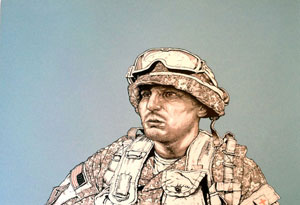Chicano Art & Self Help Graphics
While a growing number of exhibitions featuring Chicano art have been staged in museums throughout the United States in recent years, it is an art movement that arose outside the normal art establishment. Chicano art developed hand in hand with protest groups such as the United Farm Workers in California and the La Raza political party in Crystal City, Texas.
In the early twentieth century the term Chicano was coined as a derogatory term to describe poor Mexican immigrants living in the United States. But it was gradually adopted as a means of pride and self-identification during the ’60s and ’70s as civil-rights movements gathered steam.
Art was an integral part of the Chicano movement from the beginning and took some of its inspiration from earlier traditions in Mexico. A fundamental influence was the work of Jose Guadalupe Posada, who used satire in portraying the lifestyles of the upper class and peasant class alike in the late nineteenth and early twentieth centuries. Mexican artists of the 1920s and ’30s rediscovered Posada and portrayed him as a leftist hero and father of Mexican printmaking. These artists went on to form the Taller de Gráfica Popular (TGP) in Mexico City in 1937. The TGP was a collective print workshop that especially encouraged people from the middle and working classes to take part. They had a special emphasis on promoting social causes.
With expanded activism around civil rights and ethnic pride in the late 1960s, printmaking gathered these influences and blossomed into a powerful expression completely outside the official art world. What was also known as the Chicano poster movement was focused primarily in Los Angeles (centered around Self-Help Graphics), San Francisco (with La Raza Silkscreen Center and Mission Grafica), Sacramento (Royal Chicano Air Force), and Chicago, led by the artist Carlos Cortez.
One of the oldest and most successful of these studios, Self-Help Graphics and Arts (SHG) in East Los Angeles, can be seen as a direct descendent from the TGP in Mexico. Rather than focusing on “fine art” as defined by the larger culture, Chicano artists would use posters and prints, featuring accessible and popular imagery, to celebrate their Mexican-American culture while also voicing political discontent and promoting social activism.
Franciscan nun Sister Karen Boccalero formed SHG in 1971, beginning in a garage in East Los Angeles with funds provided by the local Catholic archdiocese. With additional help from Carlos Bueno, Antonio Ibañez and Frank Hernandez, the workshop flourished immediately, known as a place where anyone could go and learn to make screen prints.
The potent mix of art and activism guiding Sister Boccalero can be traced back to her education at Immaculate Heart College in Los Angeles, where she studied under Sister Corita Kent, whose prints were influential in the ’60s and ’70s. Their spirituality, combined with a commitment to social justice and peace, was a message easily adaptable to the emerging Chicano movement. What SHG added to the mix was the goal to encourage the empowerment of Chicano and Latino artists in the local community.
SHG became an integral part of the community as it expanded into larger facilities. It was an important gathering place for people actively involved in the Chicano movement, as well as a place to promote art and self-expression. Many of the artists who worked there have gone on to start other print studios, such as the Sam Coronado Studio in Austin, Texas, and Modern Multiples, founded by Richard Duardo in Los Angeles, along with many others.
Over time there has been an evolution of the movement away from its strictly Mexican-American heritage to the broader pan–Latin American community. Centers such as the Mission Grafica in San Francisco and Self-Help Graphics in Los Angeles broadened their scope to include work by artists who may have shared esthetic and political goals with the earlier movements, but who were not necessarily Chicano or even Latino.
As a result, the movement today is no longer purely Chicano or even purely ethnic. The work coming out of many studios continues to have a strong ethnic focus, but the politics are more in the background. Some younger artists, however, such as Favianna Rodriguez and Ernesto Yerena, as well as workshops such as Dignidad Rebelde, have again taken up the political and ethnic poster-making tradition.
Other artists, such as Emmanuel Montoya, Artemio Rodriguez and Juan Fuentes, have looked back to the older tradition of relief prints as exemplified by Posada and the TGP. Still others, such as Richard Duardo at Modern Multiples, incorporate more universal pop iconography. While the clearly defined boundaries of the Chicano Poster Movement are no longer visible, much of the tradition continues in various forms, even as its influence has moved outside the communities it initially served.


